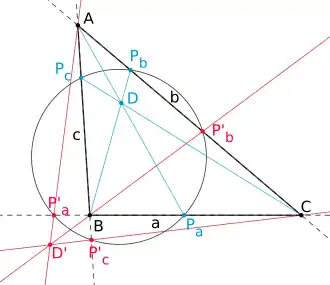Reuschle's theorem
In elementary geometry, Reuschle's theorem describes a property of the cevians of a triangle intersecting in a common point and is named after the German mathematician Karl Gustav Reuschle (1812–1875). It is also known as Terquem's theorem after the French mathematician Olry Terquem (1782–1862), who published it in 1842.

Reuschle's theorem:
cevians , and intersect in
, and intersect in
cevians , and intersect in
, and intersect in
In a triangle with its three cevians intersecting in a common point other than the vertices , or let , and denote the intersections of the (extended) triangle sides and the cevians. The circle defined by the three points , and intersects the (extended) triangle sides in the (additional) points , and . Reuschle's theorem now states that the three new cevians , and intersect in a common point as well.
References
External links
- Terquem's theorem at cut-the-knot.org
- Weisstein, Eric W. "Cyclocevian Conjugate". MathWorld.
| Wikimedia Commons has media related to Reuschle's theorem. |
This article is issued from Wikipedia. The text is licensed under Creative Commons - Attribution - Sharealike. Additional terms may apply for the media files.